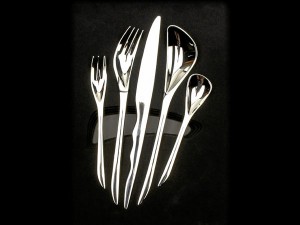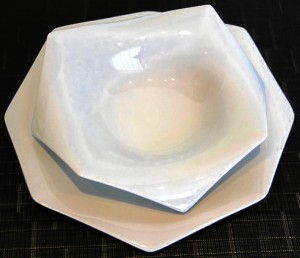
ZAHA Hadid’s flatware for WMF comes with an acrylic rest that positions the utensils in a sculptural form. The shapes of pieces themselves deviate from the norm. So how will you arrange your table setting with these?
I enjoy looking at images of tablescapes, most especially those in big weddings and events. With flowers, candles, runners and a countless assortment of accessories, they look absolutely awesome. But the awesomeness is created from the whole array of accessories and décor, and very little from the tableware itself. By tableware, I refer to the implements one would use at a meal: the plates, glasses, flatware, serving platters, napkins, their rings and all other utensils necessary to enjoy a hearty meal.
Nowadays, tableware is not very fancy. Gone are the days of traditional English porcelain or fine “china” as the West would call it, those with the tiny roses and gold rims, and the sterling silver flatware of carved and monogrammed stems. Yes, many people still use them, but I’ve packed my own into storage quite some time ago. Being of this generation, I’ve chosen to style my table differently and with much less ornamentation.
For commercial purposes, finely crafted, yet basic, tableware are often used. By basic, I mean that they are pieces that can work with almost any tablescape concept and are adaptable to any color scheme. This is especially the case for most banquet facilities that have to handle a variety of functions the assortment of décor day in and day out. The tableware has to perform like a supermodel with the X-factor, looking good with whatever it is dressed up with, quite unlike restaurants that usually own to a strong concept, and therefore, integrate their tableware into the desired visual and gastronomic experience of their establishment.
Personal style
When tablescapes are created within our own private spaces, we best assemble them according to our own personal style. I admire people who can bring together a tablescape with just the right amount of décor, with their personalities radiating and with the styling consistent to their lifestyle. Even as they create these with different concepts for varied occasions, there would be some overriding personality to the whole assembly. Coming from the one household and gathering from existing resources, a tablescape will bear witness to its owner’s method or madness.
Anyone who enjoys getting creative with food and entertaining will love to have a huge collection of flatware, porcelain, glasses and tabletop décor. But unlike a hotel’s dinnerware storage, most private places unfortunately have limited storage, if not limited budgets. I reckon that one of the best ways to go would still be just like our mothers did it: a few sets combined in different ways. A few good sets in a large armoire or its modern-day equivalent. Good sets then meant silverware and porcelain, the former of which, people would rather do without due to health issues relating to silver polish (not to mention cost), and the latter, of which people would rather have in a cleaner (visually, I mean) and more modern version of.
How tableware performs

ROSENTHAL’S ‘Origami’ does away with the regular circular forms for plates and bowls and instead mimics folded paper.
Tablescapes during events are made for the “wow” and are best appreciated when all the tables came together in a commanding scale, like when viewing them from one end of a ballroom. But human scale can bring forth another facet: the small details of the tableware, the fine nuances of the ergonomics necessary for handling, and the experience the shape and configuration provide as a user spoons his soup or forks his meal. How tableware performs can either enhance or ruin the dining experience. With today’s emphasis on design, no one can argue that part of that performance is the appearance in itself. Many unusual and unique forms available in the market make for thought-provoking conversation. While the flatware of yesteryear for example, have almost the same shape or configuration with only the designs on the grips or handles changing, today’s flatware have become sculptural and multifaceted. Plates too have gone from looking like paper, to looking like paper-folding art.
As for complicated tablescapes, I’d recommend them for big parties, or events where you had so badly to make an impression. But for little parties at home, I’d say go for a gathering of well-selected tableware. That almost always guarantees an enjoyable dining experience matched with amusing conversation.
Contact the author through designdimensions@abi.ph or through our Asuncion Berenguer Facebook account.

